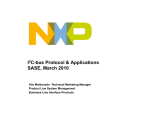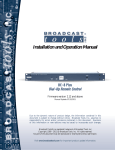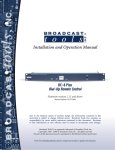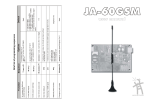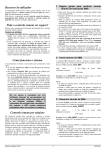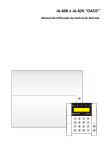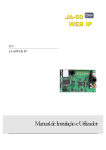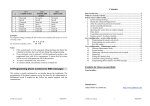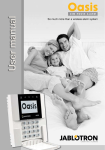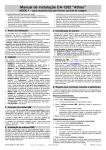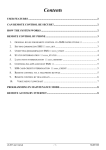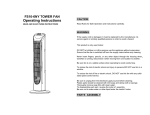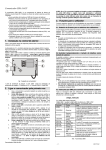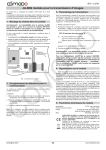Download The JA-80Y GSM communicator
Transcript
The JA-80Y GSM communicator The communicator is a component of the Jablotron Oasis 80 system. This manual is valid for software version XA61010 or higher. The communicator is designed to be installed within the control panel housing. When connected to a GSM network it allows the following: • event reporting by SMS (to up to 8 telephone numbers) • event reporting by phone call with an acoustic warning • event reporting to an ARC (Automatic Receiving Centre – also known as a Central Monitoring Station) - up to 2 ARCs • remote control and programming by phone (remotely authorizing a phone keypad or by SMS instructions) • the remote control of appliances in the house by dialling in from an authorized number (free of charge with unanswered calls) • remote control and programming via the Internet (www.GSMlink.cz) • connecting a phone set = simulated tel. line = GSM gateway function (incl. CLIP protocol = caller ID and SMS transfer) • listening-in and voice communication – via a connected SP-02 intercom • connecting a PC to the Internet (GPRS modem feature) 1. Installation in the control panel If you purchased the communicator module separately, it should first be installed in the Oasis control panel as follows: a) the control panel power must be switched off (both mains and battery) b) Fit the communicator inside the control panel housing using screws and connect its cable to the main board c) attach the adhesive GSM antenna to inside the control panel’s plastic housing (on the lower internal wall) and connect the antenna to the communicator – never switch the control panel power on if the GSM antenna is not connected to the GSM module as this will cause serious damage. d) connect the relevant cables to the communicator if you intend using the simulated telephone line, the AUX output or a PC serial data cable for the GPRS modem function If the communicator is installed in the control panel and its GSM antenna is connected then: a) have a suitable SIM card ready. It should be activated (see if it works in a mobile phone first). If it requires a PIN code when turning the phone on, then disable the PIN code request (for example in Nokia via: Menu / Settings / Security settings / PIN code request / Off). The communicator can work with a prepaid card, but for more reliable functioning use a tariff card (see 5.16). b) insert the SIM card into the communicator (to open the card holder push its frame up a little) c) switch on the control panel power (mains and battery). The communicator’s red LED should go off within a minute = successful registration to the GSM network. If the red LED starts flashing after awhile, switch off the control panel power, put the SIM card into a mobile phone and check that it registers to the network in place of the control panel and without any PIN code requests. d) close the control panel cover, the alarm system should be in Service mode - if it is not, enter ∗0 Service code (factory default: 8080) with the alarm system unset (disarmed). e) key in 98101 - to set texts of the communicator to English language. f) key in 922 to measure the GSM signal strength (should indicate in the range 0/4 to 4/4). It should be at least 2/4 for reliable functioning. If the signal is weak, change the location of the control panel or try a SIM card from another GSM provider (it is not recommended to use either a high-gain or directional antenna– see 5.2). g) if the GSM signal is sufficient, test the communicator functions (for example calling the system’s SIM card number and authorizing the phone keypad you are using) – see 3.3. If installed at a location near a national border where roaming to a foreign network is highly likely (e.g. when the signal strength is fluctuating), we recommended blocking the roaming feature in the SIM card to avoid unnecessarily high communication fees. Contact your GSM provider for details. 3. User functions of the communicator CANCEL MENU NAMES CALLS WRITE READ 2 SY MB OL SMS phone connected to RJ socket or PHONE terminals 2. Powering up the communicator for the first time The following text describes all communicator features. The installer should show the end user how to operate the functions used in a particular installation. SPACE SMS CA LL 1 2 3 3.1. Making a phone call from a connected phone MUTE 4 5 6 7 8 9 0 # FLASH AUX relay terminals REDIAL SPEAKER GSM antenna The communicator provides a simulated phone line (including CLIP protocol) to connect a phone set: • the phone (tone dialling only) should be connected to the telephone socket on the communicator board (or to the PHONE terminals) • the phone can be used as if connected to a standard telephone line (factory default settings of the communicator) • if the phone supporting SMS messages is used, then besides phone calls it is also possible to send and receive SMS messages (see 5.11.1) • the communicator terminates current phone calls if it is due to send event reports • some phone sets are sensitive to nearby GSM radio signals. If you hear strong interference in the phone receiver caused by the communicator’s GSM signal, change the location of the phone set. 3.2. Internet connection via COM port Fig. 1 Communicator wiring Listening-in and voice communication If listening-in and voice communication are needed, then an SP-02 intercom should be connected to the phone line simulated by the communicator. The intercom can be connected in parallel to any existing phone set. The SP-02 works as a speaker-phone which answers calls automatically when coming from telephone numbers authorized to access the listening-in feature. The SP-02 also provides a push-to-talk feature to call a number stored in its memory. See the SP-02 manual for details on how to authorize numbers to listen-in, and how to program the push-to-talk number. 3.3. Temporarily authorizing a phone keypad to be a system keypad It is possible to operate the system remotely by temporarily authorizing a phone keypad as follows: The JA-80Y GSM communicator -1- MFJ55304 a) dial the system’s SIM card number (if a phone is connected to the communicator’s simulated line it will start ringing) b) after 25 seconds of ringing (programmable) the system will answer with a short beep c) key in a valid access code on the telephone keypad (e.g. 8080 or 1234 if factory default settings are still valid) d) the phone keypad will behave as a system keypad and an acoustic signal in the receiver will indicate the control panel status: 1 beep = SET, 2 beeps = UNSET, 3 beeps = Service mode, 4 beeps = incorrect code entry, siren sound = alarm e) now the system can be operated from the phone keypad the same way as from the system keypad – including the commands starting with ∗ (for example ∗81 to turn the PGX output on) f) to exit this mode simply end the phone call (if nothing is entered within a minute, the phone call will end automatically anyway) Notes: do not enter sequences on the phone too fast, each key signal needs a certain time to be sent (it depends on the particular phone and the quality of the GSM connection) a fixed-line phone can also be used to operate the system remotely the same way (the phone must use tone dialling) the system can also be operated from the keypad of a phone connected directly to the communicator’s simulated line. It is only necessary to pick up its receiver and briefly press the # key. Then the phone is ready to work as a control panel keypad. To finish operating just hang up. Phone keypads have to be re-authorized each time the system is called by entering the codes specified earlier, as phone keypads are only authorized as system keypads for the duration of a call to the system. 3.4. SMS instructions to control the system remotely All incoming SMSes are checked by the communicator and if there are any instructions to the system, they will be performed. Each instruction message must have the following format: code instruction (valid code space instruction) Valid code = any valid code in the system (e.g. 8080, 1234 etc.) The factory-default instruction texts (editable – see 5.5) Instruction Function Note SET setting (arming) setting or unsetting (the same way as UNSET unsetting (disarming) STATUS status interrogation MEMORY last event interrogation turns on PGX turns off PGX turns on PGY turns off PGY turns on AUX turns off AUX PGX ON PGX OFF PGY ON PGY OFF AUX ON AUX OFF CREDIT SIM card credit interrogation if the used code is entered on the system keypad), If the system is already in the desired mode, it will not change including GSM signal strength, GPRS data, ARC communication (shown as MS1 and MS2) The last event recorded in the control panel memory the PG output has to be programmed for the function: on/off (by 237/247) or 2 second switching (by 238/248) turns a pair of AUX terminals on the communicator module on/off it has to be initialised by SMS before it can function – see 5.17 Example: by sending: “code SET” (valid code space SET) the system will set (if it is already set it will not change its status) Notes: performance of the instruction is confirmed by an SMS reply the instruction texts are not case-sensitive and only ASCII characters are allowed only one instruction can be in an instruction SMS a setting/unsetting instruction starting with the service code will only be performed if setting/unsetting with the service code is enabled in the control panel (to protect against unauthorized setting/unsetting by installers) an SMS instruction can also be sent to the alarm system from a phone connected to the communicator (if supports SMS) – to phone number 001 (for free) if there is any other text in the instruction not separated by “%”, the instruction will not be performed if you are sending an instruction and you are not sure whether any other text will be automatically added to the SMS (for example, when The JA-80Y GSM communicator using an SMS internet gate) type the instruction as: %code instruction%% 3.5. Toll-free remote control by unanswered calls from preauthorized phones A limited number of system functions can be activated remotely by calling the system from pre-authorized phones and terminating calls before the system answers. This way limited control of the system is free of call charges. It is possible to pre-authorize phone numbers stored in memories M1 to M8 (also used for event reporting – see 4). To pre-authorize a telephone number store ∗ at the end of the number and follow it by a single digit (1, 2, 3, 8 or 9) – see the notes in section 4. If this number calls, the communicator generates “∗ digit“ after the first ring (as if it had been entered manually on the system keypad). This tollfree remote control by unanswered calls enables the following functions according to the digit stored at the end (after the *) of the tel. number in memory: ∗1 setting the complete system (= ABC keypad button) ∗2 setting section A (= A button)* ∗3 setting sections A & B or B (= B button)* ∗8 PGX turns on for 2 sec. (if PGX is programmed for the pulse function) ∗9 PGY turns on for 2 sec. (if PGY is programmed for the pulse function) Notes: if a phone sends no caller identification data it cannot be used for this type of remote control by phone if phone calls end before the control panel answers, remote control is for free a phone which is pre-authorized for toll-free remote control can also temporarily authorize its keypad to fully operate the system (see 3.3) – just let it ring until the control panel answers the call if it is desired that the phone which is authorized for toll-free remote control should not receive event reports, then turn the reports off for that tel. number (see 5.4). setting (arming) with ∗1, ∗2 and ∗3 will work only if enabled in the control panel 4. Reporting to phones The communicator can report events occurring in the Oasis system by sending SMS reports and/or by calling phone numbers with an acoustic signal (mostly used as audible notification of an SMS to be read). Reporting can be programmed for up to 8 phone numbers. The most frequently desired reports are already assigned to the telephone number memories by factory-default, so you only need to program tel. numbers to the particular memories which have the desired reports already assigned. If desired, other events can be reported to the number too, i.e. the list of event reports assigned to the number can be changed (see 5.4) Factory-default reports assigned to the numbers M1 to M8 M Reports 1 Alarms and faults by SMS 2 Alarms and faults by SMS + phone call (if you answer the 3 call you hear a siren sound) 4 5 Alarms by SMS + a phone call, with Setting/Unsetting and faults by SMS only 6 Alarms by phone call (if you answer the call you hear a 7 siren sound) 8 Technical fault by SMS (suitable for an installer) To program phone numbers to the M memories, enter the following sequence while in Service mode: 81 M xxx...x ∗0 where: M is memory 1 to 8 xxx...x is a phone number (max. 20 digits) Example: entering 81 5 777 777 777 ∗0 will store the number 777777777 in memory M5 (Alarms will be reported by SMSes + phone calls, Setting/Unsetting and faults only by SMS) To erase a number from memory M enter: 81 M ∗0 Notes: Entering ∗9 before the first digit will insert a “+” for the international formatting of phone numbers -2- MFJ55304 if it is desired that the events be reported to the SMS phone connected to the communicator then program tel. number 001 into the memory SMS report text consists of: installation name, event name, number and name of the event source (device or code), date and time. Example: “Report from your alarm: setting 47: device Time 01.08. 11:27” if other events or texts should be reported to a particular number, change the communicator settings (see 5.4 and 5.5) when storing tel. numbers, if you key in ∗7 after the last digit of the phone number (the symbol ∗ is also stored) and continue with one more digit (1, 2, 3, 8 or 9), then if this tel. number calls the system, the system will behave as if ”∗ digit“ had been keyed in just after the first ring, i.e. as if it had been entered manually on the system keypad – see section 3.5. Example: entering 81 5 777 777 777 ∗79 ∗0 authorizes calls from tel. number 777777777 to trigger output PGY for 2 seconds (after the first ringing signal from this number the ∗9 command will be executed. The PGY output should be programmed for a 2 sec. pulse function. This setting is suitable for opening an electric door lock, automatic gate etc. 4.1. Programming The most convenient programming is best done by a PC running Comlink software or via the Internet and website: www.GSMLink.cz or by programming SMS – PRG sequence Programming is also possible via the system keypad: The control panel must be in Service mode - if it is not, enter ∗0 Service code (factory default: 8080) while the system is unset. Enter the relevant programming sequences – see the following description To exit service mode press the # key 5. Programming sequences Function Sequence Language setting 981 xx GSM signal strength measurement 922 Tel. number programming for reporting to telephones 81 M xx..x ∗0 Selection of events to report by SMS 82 M ec x Options Factory default xx=01 to 17 where: 01=EN,02=CZ,03=SK,04=NL,05=DE,06=PL,07 =DA,08=IT,09=PT,10=FI,11=NO,12=SV, 13=FR, 14=HU, 15=RU, 16=TR, 17=SP English On keypad or in ComLink software range 0/4 to 4/4 In reply to STATUS SMS: range 0/9 to 9/9 exit by pressing # M = memory 1 to 8 xx..x = tel. number (max.20 digits) keying in ∗9 = + and ∗7 = ∗ 81 M ∗0 erases the number in memory M M = tel. number memory from 1 to 8 ec = event code (see 5.4) x=1 report, x=0 no report Selection of events to report by phone call 83 M ec x SMS text editing* Texts can be edited by Comlink software or by SMS instruction: code TXT n,text,n,text... or by www.GSMLink.cz via Internet Enable reporting to phones 80 x Remote access 903 x Forwarding of incoming SMSes 926 x SMS instruction confirmation 927 x Reaction to incoming calls 904 x Simulated phone line function 951 x Emergency tel. number 952 xx..x ∗0 921 x 953 x 954 x GSM signal dropout indication Phone microphone sensitivity Phone speaker loudness Number to be periodically called to maintain SIM card validity 924 xx..x ∗0 x=0 disabled x=1 enabled (all programmed by 82.. & 83..) x=2 enabled without reporting setting/unsetting by users 41 to 50 (codes, cards & key-fobs) and master code setting/unsetting x=0 disabled x=1 enabled (by phone and Internet) x=0 no, x=1 yes = if the incoming text is not an SMS instruction it will be forwarded to the first programmed number in memories M1 to M8 x=0 no, x=1 yes (by SMS reply) x=0: no reaction x=1 to 8: answers after 1 to 8 rings nd x=9: answers after the 2 call x=0 tel. line (GSM gateway) x=1 alarm system keypad x=2 off x=3 automatically calls an emergency tel. number when the tel. receiver is picked up xx..x = tel. number (max.20 digits) - all M1 to M8 erased M1 & 2 alarms by SMS M3 & 4 alarms by SMS and call M5 & 6 alarms by SMS and call + Set/Unset by SMS M7 alarms by call M8 technical faults by SMS (to installer) see 5.5 enabled enabled yes yes answers after 5 rings (25s) tel. line erased x=0 no, x=1 yes (15min. dropout =Fault) no x=1 to 9 (9 = maximum) 5 xx..x = tel. number (max.20 digits), 924∗0=erase erased Using an SMS instruction to configure automatic SIM card credit interrogation * Via an SMS instruction to the alarm system: code CREDIT uu..u xx yyy zz where code = master or service code, uu..u = GSM network command string to ascertain the credit (e.g. ∗104#) , xx=auto-interrogation frequency in days, yyy=minimum acceptable balance, zz= the textual position at which the number showing the balance starts in the reply message from the GSM provider. If the credit is lower than the minimum, the provider’s SMS will be auto-forwarded to numbers M1 and M8 for someone to top up the pre-paid SIM card. Getting your www.GSMLink.cz registration code sent to your mobile phone 910 xx...x ∗0 The JA-80Y GSM communicator xx..x = your mobile phone number -3- - MFJ55304 Automatic SIM card credit interrogation Programming by SMS Triggering re-registration to the GSM network Communicator reset Credit balance checking is set by SMS instruction code_CREDIT_uu..u_xx_yyy_zz where uu..u = instruction for the GSM network (e.g. ∗101# etc.), xx= period in days, yyy=minimum balance, zz= the position in which the number showing the balance starts, If the reported credit balance is lower than the set limit (yyy), the credit balance message from the provider will be forwarded to phone numbers M1 and M8 System can be programmed remotely via SMS instruction code PRG seq, seq,... where seq is programming sequence set also from the keypad (e.g. 8080 PRG ∗08080,201,# set the 10s exit delay) 923 98080 The communicator will unregister from the GSM network and then re-register. Also possible via the SMS instruction: code GSM. Code = master, user or service code Resets to the factory default settings and erases all phone numbers, text will not be changed Memorizing the SIM card’s PIN code in the communicator 920 xx..x ∗0 Configuring the GPRS log-in parameters* by SMS instruction to the alarm system: code GPRS x..x,y..y,z..z where code = master or service code, x..x = the APN, y..y = name, z..z = password (only enter the APN if the name and password are not required by the GSM provider) ARC main tel. number/IP address 01 a xx..x ∗0 xx..x = new PIN, sequence 920∗0 erases the PIN (to use a SIM card with a disabled PIN) erased a=1=ARC1, a=2=ARC2, xx..x = tel. number (max.20 digits) or IP address & port – for example: 01 2 ∗8 192 168 001 123 08080 ∗0 (∗8= signifies an IP address, it must have 12 digits followed by a 5 digit port number). Entering 01p∗0 or 02p∗0 will erase the number/address erased ARC backup tel. number/IP address 02 a xx..x ∗0 Installation (alarm system) ID for ARC use 03 a zz..z ∗0 a=1=ARC1, a=2=ARC2, zz..z = ID number max. 8 digits 0 to 9 and ∗1=A to ∗6=F (hexadecimal number) 0000 Selecting the ARC protocol 04 a x a=1 ARC1, a=2 ARC2 x=0 CID, x=1 SMS CID, x=2 IP CID CID Selection of events to report to ARCs 05 a ec x a=1 ARC1, a=2 ARC2 ec event code (see 5.27) x=1 report, x=0 no report Defining the delay before data is resent to an ARC 06 a x a=1 ARC1, a=2 ARC2 x=0 to 9 min. (0=immediately, without delay) 1 minute ARC communication checking period (The time to wait after the last report before performing an ARC communication check) 07 a hhmm a=1 ARC1, a=2 ARC2 hhmm = hours and minutes after last report 2400 (24 hours after last report) Enable ARC reporting (ARC2 backs up ARC1) 00 a x a=1 ARC1, a=2 ARC2 x=0 reports disabled, x=1 reports enabled, x=2 (only for ARC2) = ARC2 backs up ARC1 all events are reported ARC reporting disabled Recording reports sent to ARCs in 08 x the control panel memory x=0 no (only records ARC communication faults, if communication checks are enabled) x=1 yes (all reports except communication checks) yes Indicate an ARC communication fault if a report is not successfully received by an ARC within 110 sec of transmission. 09 x x=0 no x=1 yes no 013 xx..x ∗0 IP address and port in format – e.g..: 013 ∗8 192 168 021 123 08080 ∗0 (∗8 mark IP address which must contain 12 digits, followed by 5 digits for the port.. Entering 013∗0 IP erase the setting 77.104.220.129 7070 (img.jablotron.com) 901 xx..x ∗0 xx..x = an installer-defined locking code (4 to 8 digits). Entering this code and then exiting service mode will lock the ARC settings 901∗0 will erase the code (= permanently unlocked) Unlocked 900 xx..x ∗0 xx..x = the locking code used by sequence 901 IP address for data transmission Locking the ARC settings Unlocking the ARC settings ARC programming can be temporarily enabled in service mode by entering this sequence. It will then relock on exiting service mode. These parameters effect reporting to the ARC and it is impossible to change them if the ARC settings are locked. * These parameters cannot be programmed from the system keypad, but they can be programmed by sending SMS instructions or by Comlink software. The JA-80Y GSM communicator -4- MFJ55304 5.1. Language setting 5.2. Language of the text used by the communicator can be set by instruction: Good quality GSM signals are necessary for the reliable functioning of the communicator. Entering 922 starts GSM signal measurement. The keypad then displays the signal strength in the range 1/4 to 4/4 and measurement is repeated every second (indicated by beeps). This mode allows a suitable location to be found for the control panel (or the GSM antenna). Press the # key to exit GSM signal measurement. The SMS reply to a STATUS interrogation now displays GSM signal strength in the range 0/9 to 9/9. The signal should read at least 2/4. In places with a weak signal we recommended trying another GSM provider’s SIM card. 981 xx Where: 01 02 03 04 05 06 07 08 09 EN CZ SK NL DE PL DA IT PT English Czech Slovak Dutch German Polish Danish Italian Portuguese 10 11 12 13 14 15 16 17 FI NO SV FR HU RU TR SP Finnish Norwegian Swedish French Hungarian Russian Turkish Spanish Warning: it is not recommended to use a high-gain or directional GSM antenna to get a better signal, as this way the communicator would only communicate with a single cellular base station and communication would not be stable. Also be aware that the GSM system cannot work properly if the distance from the cellular base station is longer than 30km (even if the signal is strong enough) as the time delays in the data exchange would be longer than acceptable to the GSM standard. Note: Set the language before editing the text in the system (change of the language will change the text to the factory default) Change of the language in the communicator will automatically result in changing the language in the connected keypad (also the wireless keypad if connected) Set language will not be change when reset is performed Example: by setting 98102 the Czech language will be set. Factory default : GSM signal strength measurement 5.3. Programming tel. numbers for reporting to phones See part 4. 5.4. Selection of the events reported to phones The factory-default list of reported events and their assignment to telephone numbers M1 to M8 can be altered by this sequence. The complete list of reportable events is shown in the following table. It is possible to select whether the event should be reported by an SMS or by a phone call, or by both an SMS followed by a phone call Each event has pre-programmed factory-default SMS text. These texts can be edited (see 5.5). The acoustic signals for phone call reporting are fixed and cannot be changed (e.g. an alarm is indicated by a siren sound if a reporting call is answered) 98101 = English List of events which can be reported to phones and their factory-default assignment to particular phone numbers ec Event 01 02 03 04 05 Intruder alarm - instant Intruder alarm - delayed Fire alarm Panic alarm Number of permitted incorrect code-entries exceeded Alarm triggered during control panel power-up Tamper alarm End of tamper alarm End of alarm indication Alarm cancelled by user Setting Unsetting Partial setting Codeless setting External communication fault External communication restored Fault Fault no longer present Mains dropout longer than 30 minutes Mains dropout Mains restored Discharged battery Battery OK Switching to Service Mode Leaving Service Mode PGX ON/OFF PGY ON/OFF Radio communication jamming present Internal communication fault Internal communication restored Communication test Unconfirmed alarm 06 07 08 09 10 11 12 13 14 15 16 17 18 19 20 21 22 23 24 25 26 27 28 29 30 31 32 Phone number memory M 3 4 5 1 2 6 7 S S S S S S S S SC SC SC SC SC SC SC SC SC SC SC SC SC SC SC SC C C C C 8 S S SC SC SC SC C S S S S SC S SC S SC S SC S C S S S S S S S S S S S S S S S S S S S S S S S S S S S S S S S S S S S S S S S S S S S S S S S S S S S S S S S S • Factory-default report assignment: S = SMS, C = call, SC = SMS followed by a call • External communication fault means a GSM network dropout longer than 15 minutes (if GSM network dropout indication is enabled) • The SMS information about a new picture on the server is sent to all phone numbers which are set to get reported event number 01 “Intruder alarm - instant”. This information contains a link to the new picture on the server. The JA-80Y GSM communicator -5- MFJ55304 5.4.1. Assigning events to be reported by SMS to a particular mobile phone number To link events to being reported by SMS, enter: 82 M ec x where M ec x phone number memory 1 to 8 event code 01 to 32 (see the above table) 0 = no SMS report, 1 = SMS report Example: if 82 8 03 1 is programmed and a fire alarm is triggered (event 03 in the table), it will be reported by SMS to the phone number stored in memory M8 5.5. SMS text editing The communicator contains various text strings which are used to create SMS reports and also SMS instruction text. Language of the text can be set – see 5.1. These text strings cannot be changed from the system keypad, but they can be edited by Comlink software, via the Internet (www.GSMLink.cz) or by sending the following SMS instruction: code_TXT_n,text,n,text,......n,text where code is a valid access code (e.g. factory defaults: 8080, 1234) _ is a space TXT instruction to edit texts 5.4.2. Assigning events to be reported by phone call to a particular phone number To link events to being reported by phone call, enter: 83 M ec x where M phone number memory 1 to 8 ec event code 01 to 32 (see the above table) x 0 = no phone call, 1 = call Example: if 82 1 03 1 is programmed and a fire alarm is triggered (event 03 in the table), the phone number stored in memory M1 will be called and if the call is answered, a siren sound will be heard. Notes: Phone call reports are mostly used as an audible notification to alert the user of a detailed report sent by SMS If both SMS + call reports are enabled for events, the SMS is sent first and then the number is called afterwards. But total priority is given to ARC reports if enabled (see 7.1 ) n text number (0 to 611 see the following table) , comma (or full stop) text the new text (max. 30 characters) which will replace the former text. It is invalid to enter a comma or a full stop inside the text string, but a space is valid within the text string Notes: • A single TXT instruction can change multiple texts (limited only by the maximum length of a single SMS) • the communicator is not case-sensitive and it is recommended to use only English ASCII characters (some networks do not support non-English national characters) • the communicator creates SMS reports with 5 parts: installation name, event description, source (code or device) number (01 to 50), source name, time and date • the maximum possible length of an ASCII SMS is 160 characters (only 70 characters for national characters). If this length is exceeded, the report is sent as multiple SMSes Examples: if the service code is 8080 then the SMS instruction: 8080 TXT 20,key fob Bob,21,Key fob Jane changes the description (name) of the key fobs enrolled to addresses 20 and 21 8080 TXT 605,heating on,606,heating off edits the text of the two instructions used to command the heating to be switched on and off by the PGX output (the PGX output must be programmed to have an ON/OFF function) The JA-80Y GSM communicator -6- MFJ55304 Factory-default SMS report and instruction texts n 0 1 2 3 4 5 6 7 8 9 10 11 12 13 14 15 16 17 18 19 20 21 22 23 24 25 26 27 28 29 30 31 32 33 34 35 36 37 38 39 40 41 42 43 • • • • Factory text n Factory text n Factory text n Factory text Report from your 44 Device 332 Code 504 Panic alarm alarm: 45 Device 333 Code 505 Invalid code-entries exceeded Device 46 Device 334 Code 506 Alarm when power turned on Device 47 Device 335 Code 507 Tamper alarm Device 48 Device 336 Code 508 End of tamper alarm Device 49 Device 337 Code 509 End of alarm indication Device 50 Device 338 Code 510 Alarm cancelled by user Device 201 Control panel 339 Code 511 Setting Device 202 Service code 340 Code 512 Unsetting Device 203 Annual inspection request 341 Code 513 Partial setting Device 204 Communicator 342 Code 514 Codeless setting Device 205 Keypad 343 Code 515 External communication fault Device 206 ARC code 344 Code 516 External comm. restored Device 300 Master code 345 Code 517 Fault Device 301 Code 346 Code 518 Fault no longer present Device 302 Code 347 Code 519 Mains dropout over 30 minutes Device 303 Code 348 Code 520 Mains dropout Device 304 Code 349 Code 521 Mains recovery Device 305 Code 350 Code 522 Discharged battery Device 306 Code 400 System status 523 Battery OK Device 307 Code 401 Set 524 Switching to Service Mode Device 308 Code 402 Unset 525 Leaving Service Mode Device 309 Code 403 Exit delay 526 PGX Device 310 Code 404 Entrance delay 527 PGY Device 311 Code 405 Alarm 528 Radio jamming present Device 312 Code 406 Service mode 529 Internal communication fault Device 313 Code 407 Maintenance mode 530 Internal comm. restored Device 314 Code 408 Partial setting 531 Communication test Device 315 Code 409 Discharged battery 532 Unconfirmed alarm Device 316 Code 410 Tamper alarm 601 SET Device 317 Code 411 Alarm memory 602 UNSET Device 318 Code 412 Fault 603 STATUS Device 319 Code 413 Power fault 604 MEMORY Device 320 Code 414 Unknown status 605 PGX ON Device 321 Code 415 Time: 606 PGX OFF Device 322 Code 416 Last event: 607 PGY ON Device 323 Code 417 Credit unknown 608 PGY OFF Device 324 Code 418 Credit: 609 AUX ON Device 325 Code 419 (internal use only) 610 AUX OFF Device 326 Code 420 Error while processing command 611 CREDIT Device 327 Code 421 Output turned on Numbers 01 to 50 for devices and codes are automatically generated by the Device 328 Code 422 Output turned off communicator so it is unnecessary to Device 329 Code 501 Instant alarm enter them in the text Device 330 Code 502 Delayed alarm Device 331 Code 503 Fire The communicator always automatically puts numbers from 01: to 50: in front of Device or Code names. Texts 0 to 532 are used to create SMS event reports Texts 601 and 611 are SMS instructions (to control the system remotely by SMS) Text 419 is for the internal use of the communicator, never edit it ! 9260 messages are not forwarded, but the communicator sends 5.6. them by CLIP protocol to the simulated phone line Enabling reporting to phones Event reports can be enabled as follows: 9261 messages are forwarded to the first programmed tel. number in memories M1 to M8 (e.g. if numbers are only programmed in M5 and M6, then messages will be forwarded to M5). The tel. number from which the SMS was received will be shown at the beginning of the forwarded text. 800 all SMS and call reports disabled 801 all SMS and call reports enabled 802 all reports enabled except reports of setting and unsetting by users 41 to 50 (i.e. their codes, cards and key fobs). This allows setting and unsetting done by report recipients (owners, bosses, etc.) not to be reported. Factory default setting: 801 all reports enabled 5.7. Remote access Remote access (by phone or Internet) can be enabled or disabled: 9030 disabled 9031 enabled Factory default setting: enabled 5.8. Forwarding of incoming SMS messages This feature enables the automatic forwarding of incoming SMS messages which contain no valid instructions to the system: Factory default setting: messages are forwarded 5.9. SMS instruction confirmation If the communicator receives a valid SMS instruction, the instruction sender will be made aware of its successful execution by the reception of a conformation SMS sent by the communicator. This confirmation can be disabled as follows: 9270 disabled 9271 enabled Factory default setting: enabled 5.10. Reaction to incoming calls The communicator’s reaction to incoming phone calls can be set by: 904 x The JA-80Y GSM communicator -7- MFJ55304 where 953x where x can be from 1 to 9 (max.) – factory default = 5 x=0 incoming calls are ignored x = 1 to 8 the communicator will answer after x multiplied by 5 seconds of ringing (e.g. x=4=20sec.) x=9 answers after a second call - first there must be at least one ring, then a pause (10 to 45sec.) and then just after the first ring of the second call, the call will be answered Factory default setting: 9045 – answers after 25sec. (about 5 rings) 5.11. The simulated phone line function This sequence defines the function of the phone connected to the simulated telephone line (if used). 98 y where y=0 y=1 y=2 y=3 5.15. The speaker loudness of the phone The loudness of the attached phone (intercom) can be adjusted by: 954x where x can be from 1 to 9 (max.) – factory default = 5 5.16. Number to be called to maintain SIM card validity If a prepaid SIM card is used and a lack of outgoing phone calls for a certain period cancels the validity of the SIM card, then this function offers the following: if there have been no outgoing phone calls within the last 90 days, then the communicator automatically calls the number programmed by this sequence, waits until the call is answered and then after 10 sec. automatically hangs up. 924 xx...x ∗0 where xx...x = phone number Function phone line –for making phone calls. If the # key is pressed when the receiver is picked up, the phone will work as an alarm system keypad the phone works as a system keypad, it is impossible to make phone calls the telephone line is disabled emergency call –automatically calls a preprogrammed number (see 5.12), just after the receiver is picked up. Pressing the ∗ key within 2 sec. after having picked up the receiver will switch to a dial tone and will allow the user to make phone calls Note: while the communicator is occupied with reporting events, or it is not registered to the GSM network, a busy signal is heard on the connected phone. Factory default setting: y = 0 = phone line Notes: • To erase this number enter 924 ∗0 • It is recommended to call cheap public services (e.g. weather forecasts etc.) but not toll-free numbers. Factory default setting: erased 5.17. Automatic SIM card credit interrogation The communicator is capable of checking the credit balance of its SIM card by interrogating the GSM network with an SMS containing a recognized instruction string (if the network supports this feature). There are two options: The credit balance can be checked when the user requests it by sending an SMS instruction to the communicator, or the communicator can be set to check it regularly itself. To configure credit balance checking send an SMS in the format: 5.11.1. Using an SMS phone connected to the simulated line A phone capable of sending and receiving SMS messages by CLIP protocol can be connected to the simulated phone line. In the phone, both the TX and RX numbers should be programmed to 1111. If an SMS message is sent from this phone to the phone number “001” it will go directly to the communicator (free of charge). This can be used to send instructions to the system (e.g. text programming etc.). If the communicator is programmed to report to phone number 001 the reports will be sent to the attached phone via the simulated line (free of charge). If the attached phone provides caller identification (CLIP), then the caller’s phone number will be shown on the display. 5.12. Emergency telephone number If the simulated phone line is set to emergency call mode (see 5.11), then after picking up the receiver the phone will automatically call a number programmed by: 952 xx...x ∗0 where: xxx…x is a phone number (max. 20 digits), keying in ∗9 will enter “+” for international calls To erase the number enter 952∗0 Factory default setting: the emergency number is erased 5.13. GSM signal dropout indication This selectable feature monitors connectivity with the GSM network. If enabled, it indicates problems and generates an external communication fault report if there is a GSM signal dropout longer than 15 minutes. 9210 disabled 9211 enabled Factory default setting: disabled 5.14. The microphone sensitivity of the phone The sensitivity of the attached phone (or intercom) can be adjusted by: The JA-80Y GSM communicator code_CREDIT_uu..u_xx_yyy_zz where: code _ uu..u xx yyy zz valid master or service code (e.g. 8080 or 1234) space instruction recognized by the GSM network to check the balance (e.g. ∗101# etc.) automatic checking period in days minimum acceptable credit balance the textual position in which the number showing the balance starts in the reply message from the GSM provider In addition, a new way of SIM card balance checking is now available for networks which do not support standard balance checking but provide SMS reporting after each charged transaction. In this case you can configure credit interrogation by sending the following SMS: code_CREDIT_S_xx where: code _ S xx is a valid master or service code (e.g. 8080 or 1234) is a space is literally S or s (a distinguishing mark) automatic checking period in days (optional) Simultaneously, it is necessary to disable SMS forwarding and to configure the number used to maintain SIM card validity (the SIM validity-maintenance call number). After performing the configuration you can check the balance anytime by sending the CREDIT instruction. By specifying the xx part you also request the checking to be performed automatically. On each check, the communicator performs a charged call (to the SIM validitymaintenance call number), and enables the forwarding of a single SMS from the network operator to the first pre-programmed number. Notes: • If the reported credit balance is lower than the set limit (yyy), the credit balance message from the provider will be forwarded to phone numbers M1 and M8 to remind someone to top up the SIM card. • If event 22 is programmed to be reported to any tel. numbers (M1 to M8) then the message “Discharged battery of the communicator” will be sent to these numbers if the credit balance is under the yyy limit. -8- MFJ55304 The telephone numbers M1 and M8 will also receive the GSM provider’s replay. • If only uu..u follows the CREDIT instruction (no xx yyy zz) then periodic balance checking will not be performed, but the balance will be checked immediately and the uu..u checking instruction will be memorized, so that in future it will be possible to check the balance just by sending the instruction code CREDIT. Example: sending the SMS instruction “code credit ∗101# 7 50 1” th causes the credit balance to be checked every 7 day (after the SMS has been sent) and if the balance (starting with the first character in the message from the GSM provider) is lower than 50 currency units it will be reported. LED flashes), then you either entered a wrong PIN or the GSM signal is too weak. In such a case: o enter 920∗0 while in service mode (erases the entered PIN) o disconnect the control panel power (mains and battery) o take out the SIM card and try it in a mobile phone (it should register to a GSM network when located at the control panel) o if you know the right PIN code and there is a GSM signal strong enough, put the SIM card back into the communicator, turn on the control panel power and then enter the PIN code (920 PIN ∗0) – the communicator should then register to the GSM network (its red LED should turn off within a minute) The communicator memorizes the PIN and it will use it automatically whenever it registers to the GSM network. If you are replacing the SIM card in the communicator with another one and the former one used a PIN code, first switch the control panel to service mode and enter 920∗0 to erase the former PIN code. The SIM card can then be changed. Warning: the use of prepaid cards in the communicator is risky. Some GSM providers block cards with enough credit but which are not topped up frequently enough. We strongly advise the use of tariffed SIM cards !!! 5.18. Remote programming by the SMS instruction Instruction PRG can be used to send programming and operating sequences to the alarm system: Note: The PIN code cannot be changed if the ARC settings are locked Factory default setting: The PIN code is erased 5.23. GPRS log-in parameters code_PRG_seq,seq,seq... where: code is valid access or service code (e.g. 8080 or 1234) _ space seq programming sequence usually set via the keypad Note: • In the sequence can be used characters 0 to 9, ∗ and #) • When the valid instruction is received, communicator simulates entering the keys on the keypad, comma in the SMS is taken as a pause in the sequence entering • System must be unset and switched to the service mode • The number of sequences in one SMS is limited by the maximum size of the SMS in the GSM network. GPRS data communication (wireless Internet via a GSM network) is used for remote access via the Internet and also for IP reporting to the ARC. To use GPRS data it must first be enabled (activated) in the SIM card (contact your GSM provider for details). Then the GSM network’s GPRS parameters must be programmed by sending the following SMS instruction to the communicator. code_GPRS_ x..x,y..y,z..z where: code _ x..x , y..y z..z Example: by sending SMS 8080 PRG ∗08080,201,# the exit delay will be set to 10s is a valid (master, user or service) access code (e.g. 8080 or 1234) space APN (Access Point Name) comma username (do not enter if not required) password (do not enter if not required) 5.19. Registration code for www.GSMLink.cz If remote access via the Internet is desired, then the system has to be registered on the web page: www.GSMLink.cz Each communicator has its own unique registration code, which is printed on the label attached to the communicator module. This code can also be sent by SMS to your mobile phone by the keypad entry: 910 xx...x ∗0 where xx...x is the tel. number to send the code to Notes: • It takes a certain time to receive the registration code (depends on the current traffic in the network) • The registration code has the format: xxxxx-xxxxx-xxxx 5.20. Triggering re-registration to the GSM network After 923 has been entered, the communicator quits the GSM network and then re-registers itself. This re-registration does not change any settings in the communicator. It should be used after GSM network faults or data collisions and in some networks it also has to be used after a blocked SIM card has been unblocked by the GSM provider. It is also possible (if the SIM card can still receive) to trigger GSM network re-registration by sending the SMS instruction: code GSM (code = master, user or service code). 5.21. Communicator reset Entering 98080 returns the communicator to its factory default settings and texts, erases all telephone numbers and disables reporting. The text will not be changed. 5.22. Memorizing the SIM card’s PIN code in the communicator It is recommended to use a SIM card with disabled PIN protection. If it is impossible to disable the PIN, then it can still be used by entering the following sequence (it must be entered after the control panel has been powered up). 920 PIN ∗0 Notes: Most public GSM networks only request an APN (do not enter y..y and z..z parameters in this case) The GPRS parameters can only be programmed if the system is in service mode and the ARC settings are not locked Factory default setting: APN = Internet 5.24. ARC phone numbers / IP addresses Events can be reported to up to 2 ARCs (which can be independent or ARC2 can work as ARC1’s backup). Each ARC can have its main and backup phone numbers (or IP addresses) programmed with: Main: 01 a xx....x ∗0 Backup: 02 a xx....x ∗0 where: a 1=ARC1, 2=ARC2 xxx...x tel. number (max. 20 digits) or IP address and port – entry format example: 01 2 ∗8 192 168 001 123 08080 ∗0 where ∗8 (auto-converts to #) signifies an IP address which must have 12 digits and must be followed by the 5 digits of the port number (no separators) To erase a tel. number / IP address enter: 01p∗0 or 02p∗0 If numbers / IP addresses are erased there will be no reporting to that particular ARC Note: the communicator first tries to send data to the main number / address, if it is not successful it tries the backup. Factory default setting: all tel. numbers / IP addresses erased 5.25. Installation (alarm system) ID for ARC use Example: if the SIM card PIN is 1234 enter 9201234∗0 The installation’s ID number which is sent to an ARC with every report can be programmed with: Notes: If the communicator does not register to the GSM network within 1 minute of the PIN being entered (this problem is shown by red where: The JA-80Y GSM communicator 03 a zz..z ∗0 a -9- 1=ARC1, 2=ARC2 MFJ55304 zz..z installation ID number, max. 8 characters (0 to 9 and ∗1=A to ∗6=F - hexadecimal number) address. If still unsuccessful, it then tries to re-send the data to both the ARCs again as before, but after a period defined by: Factory default setting: 0000 for both ARCs 06 a x where a 1 = ARC1, 2 = ARC2 t is the period: 0=immediately, 1 to 9 = 1 to 9 minutes 5.26. Selecting the ARC communication protocol To select the required communication protocol enter: 04 a x 5.29. ARC communication checking period where: a x Factory default setting: 1 min. for both ARCs 1=ARC1, 2=ARC2 0=Contact ID, 1=SMS CID, 2=IP CID Notes: • IP CID is the fastest of the above protocols and it also allows very frequent checking of communication reliability with the ARC (e.g. every 5 minutes) • Contact ID protocol can be used with ARCs linked by standard telephone lines (if they support Contact ID) • If your ARC does not allow SMS CID or IP CID protocols, please contact a Jablotron distributor for details on how to update your ARC. Factory default setting: Contact ID for both ARCs The time to wait after the last report sent to an ARC before performing an ARC communication check is set by this sequence. The communication-checking event code is 31 (see 5.27). This sequence programs how often the communication check is performed: 07 a hhmm where a hh mm 1 = ARC1, 2 = ARC2 hours minutes Notes: • Checking reports are not sent in service mode • IP CID protocol allows very frequent checking of ARC communication (e.g. every 5 minutes). Factory default setting:24 hours after the last report – for both ARCs 5.27. Selection of events to report to ARCs The system recognizes 32 different types of events - see the following table. This sequence allows you to select which events are reported to which ARC. 05 a ec x where a ec x 1 = ARC1, 2 = ARC2 event code 01 to 32 0 = no report, 1 = report Factory default setting: all events are reported ec 01 02 03 04 05 Event Intruder alarm - instant Intruder alarm - delayed Fire alarm Panic alarm Number of permitted incorrect code-entries exceeded 06 Alarm triggered during control panel power-up 07 Tamper alarm 08 End of tamper alarm 09 End of alarm indication 10 Alarm cancelled by user 11 Setting 12 Unsetting 13 Partial setting 14 Codeless setting 15 External communication fault 16 External communication restored 17 Fault 18 Fault no longer present 19 Mains dropout longer than 30 minutes 20 Mains dropout 21 Mains restored 22 Discharged battery 23 Battery OK 24 Switching to Service Mode 25 Leaving Service Mode 26 PGX ON/OFF 27 PGY ON/OFF 28 Radio communication jamming present 29 Internal communication fault 30 Internal communication restored 31 Communication test 32 Unconfirmed alarm Besides the events listed above, the communicator also reports some events which are not selectable here (e.g. the annual inspection request if enabled in the control panel = CID 1393) 5.28. Defining the delay before data is resent to an ARC The communicator tries to send reports to the main number / IP address, and if unsuccessful it then tries the backup number / IP The JA-80Y GSM communicator 5.30. Enable ARC reporting (ARC2 backs up ARC1) This sequence allows reporting to ARCs to be switched on/off and also enables ARC2 to backup ARC1: 00 a x where a x 1=ARC1, 2=ARC2 0=off, 1=on, 2= ARC2 backs up ARC1 (2 can only be entered for ARC2) Note: if ARC2 backs up ARC1 then it will only receive data if it is not possible to deliver it to ARC1. A report containing “Communication fault to ARC1” is then sent to ARC2 together with the first report to ARC2. Factory default setting: both ARCs = off 5.31. Recording reports sent to ARCs in the control panel memory This sequence enables the recording of every report successfully communicated to ARCs in the control panel’s internal memory. 080 enabled 081 disabled Note: it is recommended not to record reports sent to ARCs but to enable the indication of ARC communication faults (see 5.32). This saves a significant amount of control panel memory. The system initially assumes that every report is successfully delivered to ARCs, but if a report is not successfully delivered within 110 seconds of transmission, then a communication fault will be indicated and recorded. Factory default setting: enabled 5.32. Indicate an ARC communication fault if a report is not successfully received within 110 sec of transmission Enables the indication and recording of a communication fault if a report is not successfully delivered to an ARC within 110 seconds of its transmission. 090 communication faults not indicated 091 communication faults indicated Notes: • The communicator continues trying to send information to an ARC even after a communication fault has been indicated (after the data has been delivered, communication fault indication stops). • For communication-checking reports the delivery time limit (confirmation from the ARC) is 300 minutes. But if any other report is sent to the ARC it must be confirmed within 110 seconds (otherwise a communication fault will be indicated) Factory default setting: communication faults not indicated - 10 - MFJ55304 5.33. IP address for data transmission 7. Further guidance on the communicator The communicator supports transmission of special data (e.g. visual information) from the system to the set IP address, which can be set by the following sequence: 013 *8 xxx xxx xxx xxx yyyyy *0 concerning ∗8, insert these characters, to identify the following IP address which must consist of 12 digits followed by 5 digits for the port (see below) xx..x is the12 digit IP address y..y is 5 digits for the port (see manual of the communicator). Example: 013 ∗8 195 039 077 154 07070 ∗0 where: To erase the IP set 013∗0. Note: if no devices supporting this feature are in the system, do not set the IP address. Factory default : 77.104.220.129 7070 (img.jablotron.com) 5.34. Locking the ARC settings All settings which effect reporting to ARCs can be locked by a digital code: 901 xx..x ∗0 where xx..x is an installer-defined locking code (4 to 8 digits) Notes: • Exiting service mode after the locking code has been entered will lock all the settings effecting ARC communication (see the sequence list in section 5). • If ARC programming is locked, then it can be temporally enabled in service mode by entering 901 xx..x ∗0 where xx..x is the locking code. It will then relock on exiting service mode. • The ARC settings can be permanently unlocked by entering 901∗0 while ARC programming is temporally enabled – see above. This will erase the locking code. Factory default setting: ARC settings unlocked 5.35. Engineer reset supported Starting from this version the communicator firmware supports the Engineer reset feature (also requires the control panel firmware to be of version KE60108 or higher). This feature is designed for ARC (Alarm Receiving Centre) connection to satisfy the following requirements of the DD243 standard: After a confirmed alarm has been triggered, the control panel must switch to a disabled state. Switching to normal operation is then only possible using a valid ARC access code. Until then, the system remains completely disabled – no operation or programming is possible even when in Maintenance or Service mode. An ARC access code can be entered in the following ways: GSMlink SMS instruction in the field used for remote code entry *ARC-code_instruction (e.g. *12345678 STATUS) 6. GPRS modem feature The communicator can be used as a GPRS modem to connect a PC to the Internet. A suitable cable is provided with the communicator. The cable should connect a PC’s serial COM port to thae data connector on the communicator board (the cable length must not be extended). It is also necessary to install the driver in the PC, which is found on the CD ROM provided with the communicator. The SIM card used in the communicator must be GPRS-enabled and the GPRS parameters must be programmed in the communicator too (see 5.23). When the communicator’s GPRS modem function is used: • It is possible to make phone calls, but the internet data transfer rate will drop to zero during phone calls • Incoming SMS messages are stored and are processed after GPRS data transfer has been terminated. • GPRS data transfer is terminated if the communicator is due to report alarms or setting/unsetting (by SMS or by phone call). 7.1. How the communicator sends reports If there is a need to report an event (e.g. an alarm) then the communicator: • sends data to ARC1, if used (the communicator tries the main phone number / IP address, if unsuccessful then it tries the backup number / IP address). • Then it sends data to ARC2 in the same way if programmed as an independent ARC. If ARC2 is programmed as the backup to ARC1 then the data will only be sent to it if transfer to ARC1 has been unsuccessful. st nd th • Then the unit sends SMS reports (1 tel. number, 2 tel. number ….8 tel. number) st nd • Then the unit performs reporting by phone call (1 tel. number, 2 tel. th number ….8 tel. number) – each programmed number is called once whether the call has been answered or not • If all previous attempts to send data to ARCs have been unsuccessful, the next attempts occur after the programmed repeat period (see 5.28). If an alarm is cancelled by a user while it is being reported, any unsent SMSes and unperformed call reports are cancelled, but the ARC still gets a complete set of reports about events in the system. 7.2. The communicator’s LED The red LED on the communicator board indicates as follows: • regular flashing – not registered to a GSM network • lit permanently – communication in progress (registration to a GSM network, an SMS transfer or a phone call) • 3 flashes – pause – 3 flashes… - GPRS modem mode 7.3. After entering service mode the communicator: • finishes reporting to ARCs (if any is needed) and confirms successful data transmission by a short ring from the phone connected to the simulated tel. line • unfinished SMS and call reports are cancelled • unsent ARC reports are only erased if ARC tel. numbers / IP addresses or the ARC communication format or the installation ID are changed • alarm restoration reports or fault restoration reports are sent to the ARC even in service mode • changes to communicator settings do not take effect until service mode has been exited 7.4. Configuring the communicator in maintenance mode If configuring the communicator in maintenance mode is enabled (via control panel programming), then the above described programming sequences can be used to set: • tel. numbers M1 to M7 • the events reported by SMS and phone calls • GSM signal strength measurement • simulated phone line functionality • the digits of the emergency tel. number 7.5. Remote access by Internet The system can be accessed remotely via www.GSMLink.cz which allows complete programming by installers and also operating the system by end users. To access the system remotely it is necessary to: • Use a SIM card enabled for GPRS data transfer • Program the communicator GPRS parameters (APN) – also possible via www.GSMLink.cz • Register the communicator via the GSMLink web page by: o displaying www.GSMLink.cz and selecting New registration o setting your login details (name and password) o entering the communicator registration code (see 5.19) o entering the communicator SIM card tel. number o entering your system access code (user or service – this gives you access to the user menu or the installer menu accordingly) o after entering the above parameters it should be possible to establish a connection with the system (connecting takes time depending on network traffic, typically within 2 minutes). • for further access sessions you only need to enter your login details (these can be memorized by your web browser) • several people can register for internet access to the system (both installers and users) The JA-80Y GSM communicator - 11 - MFJ55304 • A service technician needs only one set of login details to access various installations. After the first system has been registered, the installer can add (or remove) other installations to(or from) his/her GSMLink account. • there is a demo version of remote access on www.GSMLink.cz • using www.GSMLink.cz is free of charge 7.6. A complete list of CID reports to ARCs A report to an ARC consists of: installation ID, event code, subsystem number and the number of the source (device or code). In IP CID and SMS CID, in addition to this, a time stamp is also sent as follows. List of the CID reports CID code 1130 / 3130 1134 / 3134 1110 / 3110 1120 / 3120 1461 / 3461 1661 / 3661 1662 / 3662 1355 1350 / 3350 1602 1138 1351 Event Intruder alarm – instant / restored Intruder alarm – delayed / restored Fire alarm / restored Panic alarm / restored Number of incorrect code-entries exceeded alarm / restored Alarm triggered during control panel power-up / restored Tamper alarm / no tampering Device tamper alarm / no tampering Alarm cancelled by user Unsetting / setting Partial setting Codeless complete setting External communication fault / restored Fault (except device) / all faults restored Device fault / all faults restored Mains dropout longer than 30 minutes / restored Battery fault (except devices) / all battery faults restored Device battery fault / all battery faults restored Switching to Service Mode / Leaving Service mode PGX ON/OFF PGY ON/OFF Radio communication jamming present Internal communication fault / restored Communication test Unconfirmed alarm Communication fault to ARC1 1393 1551 / 3551 Annual check request Communicator blocked / restored 1140 / 3140 1137 / 3137 1144 / 3144 1406 1401 / 3401 3402 3408 1354 / 3354 1300 / 3300 1330 / 3330 1301 / 3301 1302 / 3302 1384 / 3384 1306 / 3306 ec 1/9 2/9 3/9 4/9 5/9 8. Technical specifications Power 12V DC (from the control panel) Stand-by consumption about 35 mA (depends on the GSM signal) Max. consumption (during communication) 1A GSM band E-GSM / GPRS 900/1800MHz RF output power 2 W for GSM900, 1 W for GSM1800 AUX output dry NC contact, max. 60 VDC / 100 mA Complies with EN 50131-1, EN 50136-2-1, as: ATS4, ATS 5 if CID protocol is used and the repeating period is set to zero (sequence 06a0) Security grade 2 Operating environment ( –10 to 40°C) class II Safety EN 60950-1 EMC ETSI EN 301489-1, ETSI EN 301489-7 EN 55022, EN 50130-4 Radio transmissions ETSI EN 301419-1 and EN 301511 CLIP protocol (caller ID + SMS) ETSI EN 300 089 V3.1.1(2000-12) Can be operated according to: ERC/DEC 98(20,21) Jablotron Ltd. hereby declares that the JA-80Y is in compliance with the essential requirements and other relevant provisions of Directive 1999/5/EC. The original of the conformity assessment can be found at www.jablotron.com, - Technical Support section 6/9 Note: Although this product does not contain any harmful materials we suggest you return the product to the dealer or directly to the producer after use. 7/8 7/8 10 12 / 11 13 14 15 / 16 17 / 18 17 / 18 19, 20 / 21 22 / 23 22 / 23 24 / 25 26 27 28 29 / 30 31 32 to ARC2 if backups 17 31 only in IP CID List of source numbers Source number 701 731 741 001 - 050 500 599 501 - 550 Source Control panel Communicator Wired keypad Devices 01 - 50 Master code Service code Codes 01 - 50 Subsystem: 01 in all reports In a split system, for setting and unsetting: 02 = A, 03 = B For partial setting: 02 = A, 03 = AB The JA-80Y GSM communicator - 12 - MFJ55304












